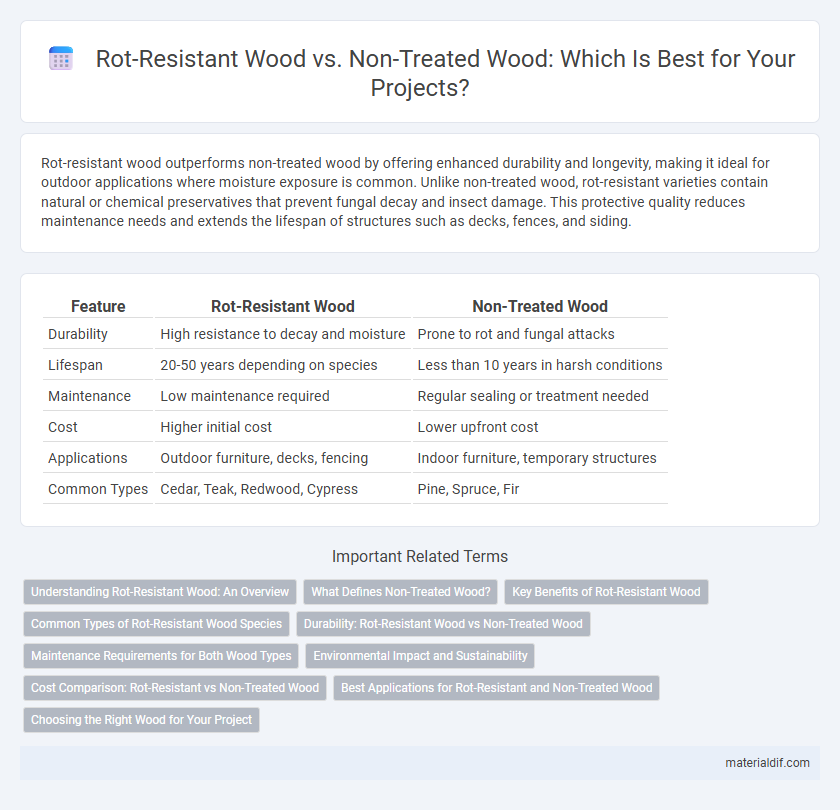Rot-resistant wood outperforms non-treated wood by offering enhanced durability and longevity, making it ideal for outdoor applications where moisture exposure is common. Unlike non-treated wood, rot-resistant varieties contain natural or chemical preservatives that prevent fungal decay and insect damage. This protective quality reduces maintenance needs and extends the lifespan of structures such as decks, fences, and siding.
Table of Comparison
| Feature | Rot-Resistant Wood | Non-Treated Wood |
|---|---|---|
| Durability | High resistance to decay and moisture | Prone to rot and fungal attacks |
| Lifespan | 20-50 years depending on species | Less than 10 years in harsh conditions |
| Maintenance | Low maintenance required | Regular sealing or treatment needed |
| Cost | Higher initial cost | Lower upfront cost |
| Applications | Outdoor furniture, decks, fencing | Indoor furniture, temporary structures |
| Common Types | Cedar, Teak, Redwood, Cypress | Pine, Spruce, Fir |
Understanding Rot-Resistant Wood: An Overview
Rot-resistant wood, such as cedar, redwood, and black locust, contains natural oils and compounds that inhibit fungal growth, providing enhanced durability in outdoor and moisture-prone environments. Non-treated wood lacks these protective properties, making it more susceptible to decay, insect damage, and structural weakening over time. Selecting rot-resistant wood reduces maintenance costs and extends the lifespan of wooden structures exposed to weather elements.
What Defines Non-Treated Wood?
Non-treated wood is natural timber that has not undergone chemical or preservative treatments to enhance durability or resistance to decay. It is susceptible to environmental factors such as moisture, fungi, and insect damage, leading to faster deterioration compared to rot-resistant wood. This untreated quality makes it ideal for indoor applications but less suitable for outdoor or high-moisture environments.
Key Benefits of Rot-Resistant Wood
Rot-resistant wood offers superior durability by naturally resisting decay and fungal growth, significantly extending the lifespan of outdoor structures compared to non-treated wood. Its low maintenance requirements reduce the need for frequent repairs or replacements, making it a cost-effective choice for decking, fencing, and outdoor furniture. Enhanced resistance to moisture and insects ensures structural integrity and aesthetic appeal, providing long-term value in various environmental conditions.
Common Types of Rot-Resistant Wood Species
Common types of rot-resistant wood species include cedar, redwood, cypress, and teak, prized for their natural oils and dense grain that resist moisture and fungal decay. Cedar contains phenolic compounds that act as natural preservatives, while redwood's high tannin content offers robust protection against rot and insects. Cypress possesses a unique cypressene oil that deters decay, and teak's dense oily grain makes it an ideal choice for outdoor furniture and marine applications without requiring chemical treatments.
Durability: Rot-Resistant Wood vs Non-Treated Wood
Rot-resistant wood, such as cedar, redwood, and teak, offers significantly higher durability by naturally withstanding moisture, fungal decay, and insect damage compared to non-treated wood. Non-treated wood tends to absorb water and is more susceptible to rot, leading to a shorter lifespan and increased maintenance costs. Using rot-resistant wood enhances structural integrity and reduces long-term replacement needs in outdoor and high-moisture environments.
Maintenance Requirements for Both Wood Types
Rot-resistant wood requires significantly less maintenance due to its natural ability to resist decay, mold, and insect damage, reducing the need for frequent sealing or chemical treatments. Non-treated wood demands regular maintenance including sealing, staining, or painting to protect against moisture, rot, and pest infestations, increasing long-term upkeep costs. Proper maintenance extends the lifespan of both wood types, but rot-resistant varieties offer a more cost-effective and time-efficient solution for outdoor applications.
Environmental Impact and Sustainability
Rot-resistant wood, such as cedar and redwood, offers enhanced durability and reduces the need for frequent replacement, thereby minimizing resource consumption and waste generation. Non-treated wood, while more biodegradable, tends to deteriorate faster, leading to increased harvesting pressures and higher carbon emissions from production cycles. Choosing rot-resistant wood supports sustainable forestry practices by extending product lifespan and lowering the environmental footprint associated with timber harvesting.
Cost Comparison: Rot-Resistant vs Non-Treated Wood
Rot-resistant wood typically commands a higher upfront cost compared to non-treated wood due to its natural durability and longer lifespan, which reduces maintenance and replacement expenses over time. Non-treated wood is more affordable initially but often incurs increased costs from frequent repairs, treatments, and potential rot damage in moist environments. Investing in rot-resistant wood offers better long-term economic value despite the higher initial price point.
Best Applications for Rot-Resistant and Non-Treated Wood
Rot-resistant wood, such as cedar, redwood, and cypress, is ideal for outdoor applications exposed to moisture like decks, fences, and garden furniture due to its natural ability to withstand decay and fungal growth. Non-treated wood, including pine or fir, is best suited for indoor projects or covered environments where exposure to water and humidity is minimal to prevent deterioration. Choosing rot-resistant wood reduces maintenance needs and extends lifespan in high-moisture settings, while non-treated wood offers cost-effective options for dry, controlled-use cases.
Choosing the Right Wood for Your Project
Rot-resistant wood such as cedar, redwood, and teak offers superior durability and longevity compared to non-treated wood, making it ideal for outdoor projects exposed to moisture and insects. Non-treated wood, typically softer and more affordable, may require frequent maintenance, including sealing and staining, to prevent decay and damage. Selecting rot-resistant wood ensures structural integrity and reduces long-term costs, especially in environments with high humidity or direct exposure to the elements.
Rot-resistant wood vs Non-treated wood Infographic

 materialdif.com
materialdif.com